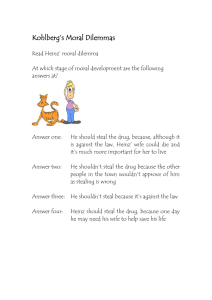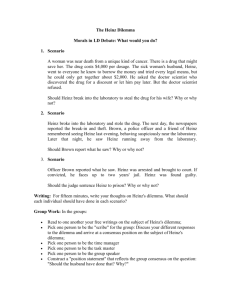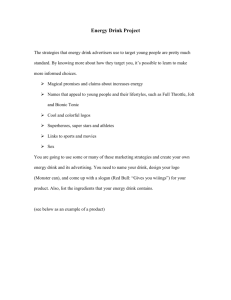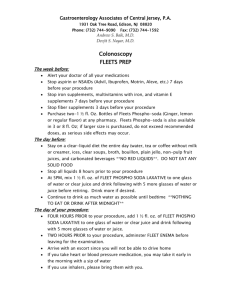Brian Edelbach
advertisement
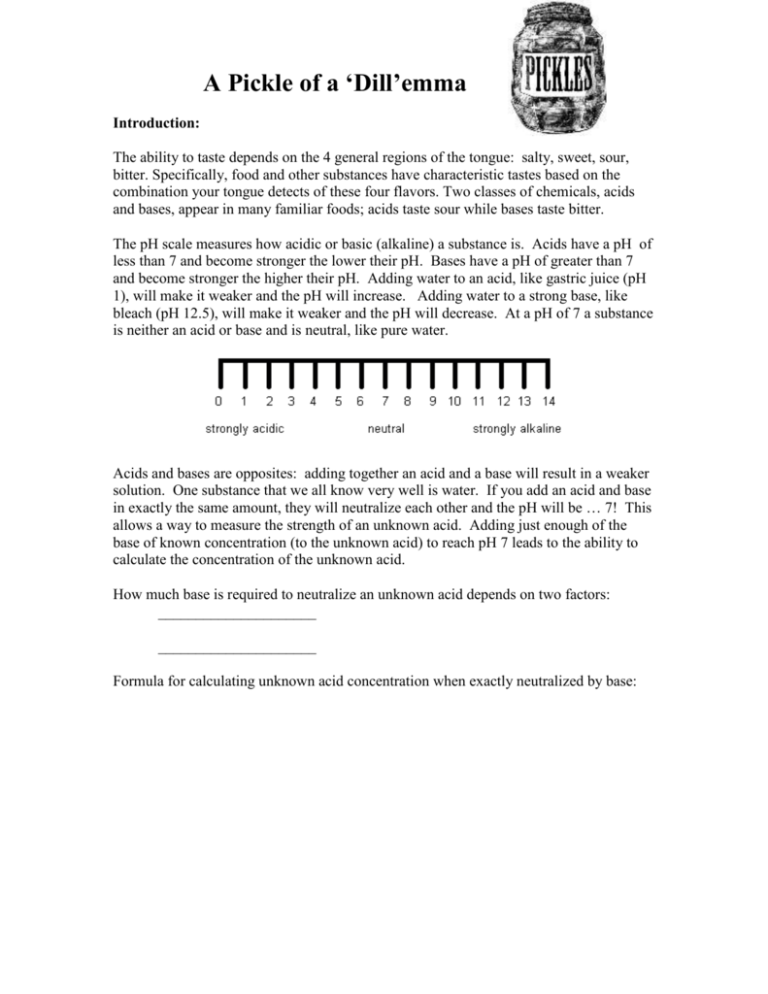
A Pickle of a ‘Dill’emma Introduction: The ability to taste depends on the 4 general regions of the tongue: salty, sweet, sour, bitter. Specifically, food and other substances have characteristic tastes based on the combination your tongue detects of these four flavors. Two classes of chemicals, acids and bases, appear in many familiar foods; acids taste sour while bases taste bitter. The pH scale measures how acidic or basic (alkaline) a substance is. Acids have a pH of less than 7 and become stronger the lower their pH. Bases have a pH of greater than 7 and become stronger the higher their pH. Adding water to an acid, like gastric juice (pH 1), will make it weaker and the pH will increase. Adding water to a strong base, like bleach (pH 12.5), will make it weaker and the pH will decrease. At a pH of 7 a substance is neither an acid or base and is neutral, like pure water. Acids and bases are opposites: adding together an acid and a base will result in a weaker solution. One substance that we all know very well is water. If you add an acid and base in exactly the same amount, they will neutralize each other and the pH will be … 7! This allows a way to measure the strength of an unknown acid. Adding just enough of the base of known concentration (to the unknown acid) to reach pH 7 leads to the ability to calculate the concentration of the unknown acid. How much base is required to neutralize an unknown acid depends on two factors: _____________________ _____________________ Formula for calculating unknown acid concentration when exactly neutralized by base: Pre lab: 1. Name 3 common foods that are acidic (taste ______________) _______________ _______________________ ____________ 2. Name 3 common foods that are basic (taste ______________) _______________ _______________________ ____________ Look up on the web ‘Yamada’s universal indicator’. 3. List the pH indicators in Yamada’s. 4. Also note the range in color change and construct a table for the indicators in Yamada’s (for pH and color change). Procedure: A: Testing Household Substances -Make a table suitable to record pH results of the provided household substances and indicators: Indicators chemicals Phenolphthalein bromothymol blue methyl orange red cabbage juice extract Vernier pH probe Yamada’s universal indicator vinegar ammonia lemon juice soft drink (clear!) detergent Baking soda aspirin -Predict the color change for the Yamada’s universal indicator and add to data table. B: Determination of Concentration of Unknown Acid (Titration Curve): 1. Obtain and wear goggles 2. Obtain the following lab equipment: 100 ml waste beaker 250 ml titration beaker, either pH meter or pH probe system (Vernier) distilled water bottle graduated cylinder 3. Observe demonstration of equipment and technique by instructor 4. Fill burette (or reservoir) with 50 ml 0.1 M NaOH 5. Into titration beaker, add: a. 10 ml of unknown acid b. 40 ml water c. 3 drops of your choice of indicator d. note and record beginning color of titration solution e. note and record beginning pH 6. Note that the titration directions will depend on whether you use the pH meter or the pH probe/computer set up pH meter Add 1 ml of base from burette, then record: pH Color of indicator Total volume of base added Continue procedure until pH reaches 12 7. Graph results: pH probe/computer set up Click ‘collect’ in upper right Turn stop cock until flow rate is approximately 1-2 drops per second Note pH when indicator changes color Continue procedure until pH reaches 12 Click ‘stop’ in upper right what is the independent variable _______________ what is the dependent variable _______________ on the graph, indicate: the neutralization point the acidic region the basic region 8. Clean up according to instructor’s directions C: Forensics File: Peter Vlasic and Henrietta Heinz both attended a lavish birthday party at Jillian’s, catered by Wegman’s. Peter Vlasic, a known practical joker, was observed adding an unknown liquid to Henrietta Heinz’s water during the celebration. Ms. Heinz was found dead just a few hours after drinking this unknown solution. The medical examiner’s report lists intestinal bleeding and gastric ulcers, typical of intake of concentrated acid. Although Ms. Heinz’s drink was emptied and the drink glass cleaned up, Mr. Heinz admitted to adding a small amount of pickle juice from a flask. liquid used in the Vlasic factory The prosecution argues that Vlasic pressured Heinz for access to a family secret recipe and when Henrietta refused, Vlasic added a strong acid to her drink from the flask. The defense argues that Henrietta drank too much and was self pickled from the evening’s alcohol. Unfortunately, a sloppy technician (rumored to be a dismissed Heinz employee) spilled ketchup into Ms. Heinz’s blood sample and, therefore, the alcohol tests are unreliable. The only evidence that can clear Vlasic is a sample from his flask. Peter claims that he added only a small amount of pickle juice from the flask, not enough to hurt anyone or to make a noticeable change in the volume of Ms. Heinz’s drink. As a forensics technician, you are to determine: - Determine the concentration of acidic solution added from the flask Make an estimate of the volume that was added to Heinz’s drink estimate the concentration of the liquid in Heinz’s drink Analysis: A. 1. Explain how a universal indicators works. 2. What are the limitations to red cabbage juice extract when used as a pH indicator? B. 3. What is the concentration of the unknown acid and show your work. C. 4. What is the concentration of the acid from Vlasic’s flask and show your work. 5. What was the estimate of the volume that was added – explain the method and reasoning your group chose to determine this value. 6. Estimate the concentration of the acid content of Heinz’s drink after Vlasic contaminated it. 7. Locate and cite a reference to evaluate the potential harm due to the calculated acid strength of Henrietta’s drink. 8. Examine your procedure and the case history. Then apply this to your laboratory results to discuss the range of confidence in your results. 9. Research a real forensics case involving chemical analysis. a. Provide the source of the case b. Brief summary of the case, and the c. Description of chemical analysis involved. Lab Requirements: - Title of lab - Abstract - table from part A (pH for household chemicals using various indicators) - table from part B (pH and color of indicators) - graph of titration curve - Answer questions from analysis in complete sentences – you must show question (you can paste these from teacher’s web page) Teacher Supplement Red Cabbage Extract pH chart *Have students suggest other logical samples to test, e.g., other person’s drink, Peter’s stomach contents, Henrietta’s stomach contents, the bartender’s water source, Henrietta’s blood sample Yamada's universal indicator: Dissolve 0.0025 g of thymol blue, 0.06 g of methyl red, 0.030 g of bromothymol blue, and 0.05 g of phenolphthalein in 50 mL of 95% ethanol. Add 0.01 mol L–1 aqueous sodium hydroxide solution until the mixture is green, and dilute the resulting solution to 100 mL with distilled water Yamada's Universal Indicator exhibits the colors of the visible spectrum: pH 10 violet pH 6 yellow pH 9 indigo pH 5 orange pH 8 blue pH 4 red pH 7 green To prepare 200 mL of stock solution, dissolve 0.005 g Thymol Blue 0.012 g Methyl Red 0.060 g Bromothymol Blue 0.100 g Phenolphthalein in 100 mL of ethanol. Neutralize the solution (to green) with 0.05 M NaOH and dilute to 200 mL with water.

